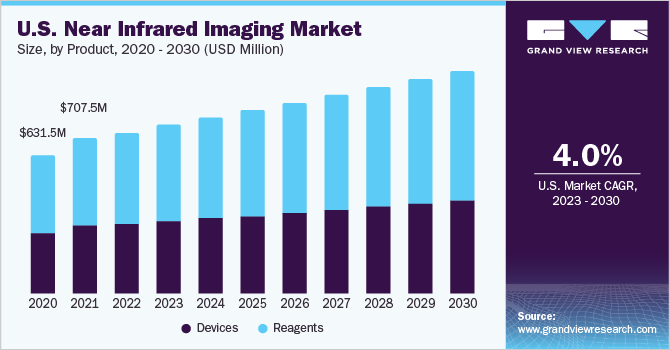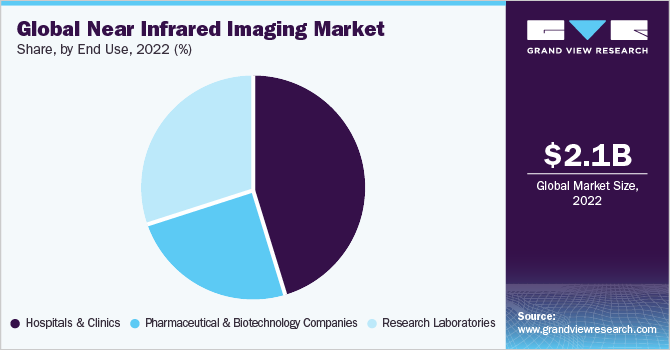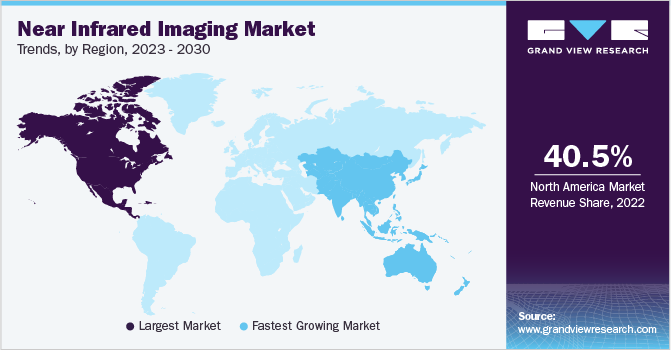- Home
- »
- Medical Devices
- »
-
Near Infrared Imaging Market Size, Industry Report, 2030GVR Report cover
![Near Infrared Imaging Market Size, Share & Trends Report]()
Near Infrared Imaging Market Size, Share & Trends Analysis Report By Product (Devices, Reagents), By Application (Cancer Surgeries, Gastrointestinal Surgeries), By End-use, By Region, And Segment Forecasts, 2023 - 2030
- Report ID: GVR-3-68038-892-3
- Number of Report Pages: 102
- Format: PDF, Horizon Databook
- Historical Range: 2018 - 2021
- Forecast Period: 2023 - 2030
- Industry: Healthcare
Near IR Imaging Market Size & Trends
The global near infrared imaging market size was valued at USD 2.06 billion in 2022 and is expected to grow at a compound annual growth rate (CAGR) of 3.9% from 2023 to 2030. Increasing incidence of target diseases, such as cardiovascular diseases (CVDs), gastrointestinal, neurovascular, and cancer, is likely to boost the demand for near infrared imaging in the coming years. According to the WHO, CVDs account for about 17.9 million deaths each year globally. Moreover, growing demand for technologically advanced fluorescence imaging systems and various initiatives undertaken by key market players is anticipated to boost the overall market growth. For instance, in September 2022, Sony, Olympus, and Sony Olympus Medical Solutions collaborated to develop a surgical endoscopy system that supports 4K, 3D, and infrared imaging features.

The COVID-19 pandemic affected the market for near infrared imaging as these are critical care medical devices and are mainly used during surgical procedures. The restrictions led to a decrease in demand for near infrared imaging devices as the medical settings redirected their sources on essential and life-saving devices. However, now since the pandemic restrictions have been lifted, the market is expected to grow at a significant rate over the forecast period. According to the annual report published by Olympus, recovery from COVID-19's effects led to positive growth from the previous fiscal year in the surgical endoscopes market. Sales of surgical endoscopic system VISERA ELITE II were especially robust in North America and Europe.
Increase in the adoption of surgical interventions has augmented the usage of visualization equipment to perform the surgery. Microsurgery has been chosen by several individuals on large scale due to rising prevalence of chronic diseases caused by stress, work pressure, improper eating habits, sedentary lifestyle, exposure to chemicals, and heredity. Furthermore, increasing awareness among the population owing to the benefits of treating a medical condition with surgery at the proper stage is boosting the demand for surgical procedures, thereby increasing adoption rate of near infrared imaging. According to a report published by American Society of Plastic Surgeons (ASPS), in 2020 about USD 16.7 billion was spent on cosmetic procedures in the U.S. These factors are expected to positively impact the market during the forecast period. Hence, the rise in surgical procedures is expected to fuel the market for near infrared imaging over the forecast period.
A constant rise in the geriatric population is increasing the financial burden on the healthcare system. According to the Global Health and Aging report by the WHO, the number of people with age 65 and more is anticipated to rise from approximately 524 million in 2010 to nearly 1.5 billion by 2050, especially in developing economies. Such a rise in the elderly population base will subsequently result in the greater application of near infrared imaging, hence supporting market growth.
Near-infrared imaging has a wide range of applications including physiological diagnostics and study of pulse oximetry, blood sugar, sports medicine, urology, and neurology. Besides, there are more than 250 clinical trials to explore potential applications of this technique in other applications. Early detection of Alzheimer’s disease with the help of non-invasive near-infrared spectroscopy is expected to have a significant impact on the usage of the NIR technique in neurology. Functional near-infrared spectroscopy is integrated with optical imaging technology and is increasingly used in the neuroimaging domain.
Product Insights
The reagents segment dominated the market for near infrared imaging and accounted for the largest revenue share of 56.6% in 2022. The segment is expected to witness a significant growth over the forecast period as reagents offer several advantages over traditional visible light dyes including high sensitivity and specific detection in biological systems. Reagents are sub-categorized as Indocyanine Green (ICG) and other reagents. The reagents segment is expected to grow considerably during the forecast period owing to the benefits offered by ICG. Indocyanine green offers real-time angiographic images during brain tumor or vascular surgery. Moreover, it is increasingly being used for spine surgery. Hence, growing applications of ICG along with its advantages are the major drivers of the segment.
The novel point-of-care near infrared imaging modalities provide the sensitivity of nuclear medicine techniques and offer radiation-free and noninvasive imaging. The device segment is expected to witness lucrative growth owing to the launch and approval of near infrared imaging systems for use in surgical procedures. The segment is further classified into near-infrared fluorescence imaging systems and near-infrared fluorescence and bioluminescence imaging systems.
Application Insights
The preclinical imaging segment dominated the market for near infrared imaging and held the largest revenue share of 34.90% in 2022. The cancer surgeries segment is expected to witness a CAGR of 4.9% during the forecast period owing to the increasing prevalence of cancer on a global scale. For instance, according to International Agency for Research on Cancer in 2020, there were about 19,292,789 new cancer cases globally, the same source states that the number is expected to reach 50,550,287 by 2025.
Near-infrared (NIR) regents are used in preclinical imaging research to study diseases and conditions such as cancer, inflammation, infection, vascular, and others. The development of advanced NIR reagents with improved fluorescence, tissue penetration, and targeted fluorescence capabilities promotes its adoption into preclinical research. For instance, COX 2 probe- a targeted NIR dye developed by PerkinElmer Inc. detects cyclooxygenase-2, produced in early-stage cancer Such dyes are used in faster clinical development of oncology drugs and diagnostic devices.
Neurological complications are common during cardiovascular procedures such as coronary surgery and valve replacement. Thereby, it is important to monitor the cerebral oxygenation level during cardiac surgeries to improve surgical outcomes. The strong impetus of implementing measures to monitor cerebral desaturation during cardiac surgery is a key factor promoting the adoption of NIR imaging.
End-use Insights
The hospitals and clinics segment captured the largest revenue share of over 45.3% in 2022 and is expected to grow at a fastest rate during the forecast period. This growth is owing to an increase in the number of admissions of cancer patients in clinics and hospitals and well-established healthcare facilities in developed countries. Near infrared technologies are widely used in hospitals and clinics for detection of bedsores to prevent surgical errors. Laparoscopic devices integrated with near infrared sensors help surgeons to avoid accidental cutting of blood vessels. The adoption of these devices helps in reducing surgical errors and minimizing the duration of hospital stay and healthcare costs for patients. The increasing patient demand for minimally invasive and efficient surgical methods is expected to boost the demand for near infrared products.

The pharmaceutical and biotechnology companies segment is also anticipated to witness a significant CAGR over the forecast period. Near infrared imaging is used in pharmaceutical companies to measure the critical material attributes of a product. They are used in pharmaceutical and biotechnology companies for identification of raw materials, verification of the quality of lyophilized materials, monitoring coating and content of tablets, monitoring fermentation and cell culture, and various in-line and on-line process monitoring.
Regional Insights
North America dominated the market for near infrared imaging and accounted for the largest revenue share of 40.49% in 2022 and is expected to witness a growth rate of over 4.0% over the forecast period. This growth is owing to the high disposable income of consumers, speedy adoption of technologically advanced medical devices, and diagnostic techniques. A large number of cancer cases reported in the country are expected to boost the market in the U.S. According to International Agency for Research on Cancer, around 2,281,658 new cancer cases were identified in 2020 in the U.S. In addition, rise in the number of reconstructive and cosmetic surgeries in the country owing to increased spending and rising awareness regarding early diagnosis is expected to create robust growth opportunities.

In Asia Pacific, the market for near infrared imaging is anticipated to witness the fastest CAGR over the forecast period. The presence of developing countries such as China, India, and Japan is anticipated to boost the growth of the market in the region. The presence of a huge population base with low per capita income in the Asia Pacific region has led to high demand for affordable treatment options. Multinational companies are keen to invest in developing countries, such as Japan, India, South Korea, and more. Thus, many market players are entering into strategic alliances with local players. This is anticipated to augment the near infrared imaging market growth.
Key Companies & Market Share Insights
The key players are focusing on growth strategies, such as new product launches, expansion, collaborations, partnerships, and acquisitions. For instance, in January 2021, KARL STORZ announced the launch of the system named IMAGE1 S Rubina multimode visualization, the latest advancement in endoscopic imaging. This technology combines state-of-the-art 4K resolution with superior fluorescence-guided imaging using indocyanine green dye and near-infrared light and (NIR/ICG). Some of the prominent players in the near infrared imaging market include:
-
Quest Medical Imaging B.V.
-
Stryker
-
KARL STORZ SE & Co. KG
-
Olympus
-
Hamamatsu Photonics K.K
-
Mizuho Medical Co, Ltd.
-
Shimadzu Corporation
-
Leica Microsystems
-
Medtronic (Visionsense)
-
PerkinElmer, Inc.
-
Carl Zeiss Meditec
-
Fluoptics
Near Infrared Imaging Market Report Scope
Report Attribute
Details
Market size value in 2023
USD 2.15 billion
Revenue forecast in 2030
USD 2.82 billion
Growth rate
CAGR of 3.9% from 2023 to 2030
Base year for estimation
2022
Historical data
2018 - 2021
Forecast period
2023 - 2030
Report updated
June 2023
Quantitative units
Revenue in USD million and CAGR from 2023 to 2030
Report coverage
Revenue forecast, company ranking, competitive landscape, growth factors, and trends
Segments covered
Product, application, end-use, region
Regional scope
North America; Europe; Asia Pacific; Latin America; Middle East & Africa
Country scope
U.S.; Canada; U.K.; Germany; France; Italy; Spain; Japan; China; India; Thailand; South Korea; Brazil; Mexico; Columbia; Argentina; South Africa; Saudi Arabia; UAE
Key companies profiled
Quest Medical Imaging B.V.; Stryker; KARL STORZ SE & Co. KG; Olympus; Hamamatsu Photonics K.K.; Mizuho Medical Co, Ltd.; Shimadzu Corporation; Leica Microsystem (Danaher); Medtronic (Visionsense); Perkinelmer Inc.; Fluoptics; Carl Zeiss Meditec AG
Customization scope
Free report customization (equivalent up to 8 analyst’s working days) with purchase. Addition or alteration to country, regional & segment scope
Pricing and purchase options
Avail customized purchase options to meet your exact research needs. Explore purchase options
Global Near Infrared Imaging Market Report Segmentation
This report forecasts revenue growth at global, regional, and country levels and provides an analysis of the latest industry trends in each of the sub-segments from 2018 to 2030. For the purpose of this study, Grand View Research has segmented the global near infrared imaging market report on the basis of product, application, end use, and region:
-
Product Outlook (Revenue, USD Million, 2018 - 2030)
-
Devices
-
Near-infrared Fluorescence Imaging Systems
-
Near-infrared Fluorescence & Bioluminescence Imaging Systems
-
-
Reagents
-
Indocyanine Green (ICG)
-
Other Reagents
-
-
-
Application Outlook (Revenue, USD Million, 2018 - 2030)
-
Preclinical Imaging
-
Cancer Surgeries
-
Gastrointestinal Surgeries
-
Cardiovascular Surgeries
-
Plastic/Reconstructive Surgeries
-
Other Applications
-
-
End-use Outlook (Revenue, USD Million, 2018 - 2030)
-
Hospitals & Clinics
-
Pharmaceutical & Biotechnology Companies
-
Research Laboratories
-
-
Regional Outlook (Revenue, USD Million, 2018 - 2030)
-
North America
-
U.S.
-
Canada
-
-
Europe
-
U.K.
-
Germany
-
France
-
Spain
-
Italy
-
-
Asia Pacific
-
Japan
-
China
-
India
-
Thailand
-
South Korea
-
-
Latin America
-
Brazil
-
Mexico
-
Argentina
-
Colombia
-
-
Middle East & Africa
-
South Africa
-
Saudi Arabia
-
UAE
-
-
Frequently Asked Questions About This Report
b. The global near infrared imaging market size was estimated at USD 2.06 billion in 2022 and is expected to reach USD 2.15 billion in 2023.
b. The global near infrared imaging market is expected to grow at a compound annual growth rate of 3.9% from 2023 to 2030 to reach USD 2.82 billion by 2030.
b. Reagents segment dominated the near-infrared imaging market with a share of 56.6% in 2022. This is attributable to the benefits offered by Indocyanine green (ICG).
b. Some key players operating in the near infrared imaging market include Quest Medical Imaging B.V., Stryker, KARL STORZ SE & Co. KG, Olympus, Hamamatsu Photonics K.K, Mizuho Medical Co, Ltd., Shimadzu Corporation, Leica Microsystems, Visionsense, PerkinElmer, Inc., Carl Zeiss Meditec, Fluoptics, and Intuitive Surgical
b. Key factors that are driving the near infrared imaging market growth include the increasing number of surgical procedures worldwide due to the high prevalence of lifestyle-associated chronic diseases and technological advancement.
Share this report with your colleague or friend.
![gvr icn]()
NEED A CUSTOM REPORT?
We can customize every report - free of charge - including purchasing stand-alone sections or country-level reports, as well as offer affordable discounts for start-ups & universities. Contact us now
![Certified Icon]()
We are GDPR and CCPA compliant! Your transaction & personal information is safe and secure. For more details, please read our privacy policy.
We are committed towards customer satisfaction, and quality service.
"The quality of research they have done for us has been excellent."





